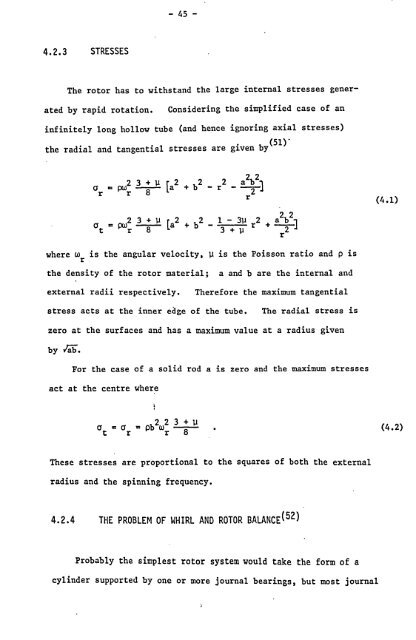NNR IN RAPIDLY ROTATED METALS By - Nottingham eTheses ...
NNR IN RAPIDLY ROTATED METALS By - Nottingham eTheses ...
NNR IN RAPIDLY ROTATED METALS By - Nottingham eTheses ...
You also want an ePaper? Increase the reach of your titles
YUMPU automatically turns print PDFs into web optimized ePapers that Google loves.
4.2.3 STRESSES<br />
- 45 -<br />
The rotor has to withstand the large internal stresses gener-<br />
ated by rapid rotation. Considering the simplified case of an<br />
infinitely long hollow tube (and hence ignoring axial stresses)<br />
the radial and tangential stresses are given by(5l)<br />
a<br />
r=r8l<br />
23+u [a2+b2-r2-a2b2-<br />
Q= pw2 3+u ra2 3u<br />
+ b2 -1- r2 + a2b2<br />
tr8L 3+ 11<br />
r2<br />
where Wr is the angular velocity, p is the Poisson ratio and p is<br />
the density of the rotor material; a and b are the internal and<br />
external radii respectively. Therefore the maximum tangential<br />
stress acts at the inner edge of the tube. The radial stress is<br />
zero at the surfaces and has a maximum value at a radius given<br />
by ab.<br />
For the case of a solid rod a is zero and the maximum stresses<br />
act at the centre where<br />
at =a =pb2w2 3 8u<br />
These stresses are proportional to the squares of both the external<br />
radius and the spinning frequency.<br />
4.2.4 THE PROBLEM OF WHIRL AND ROTOR BALANCE(52)<br />
Probably the simplest rotor system would take the form of a<br />
cylinder supported by one or more journal bearings, but most journal<br />
r2<br />
(4.1)<br />
(4.2)

















